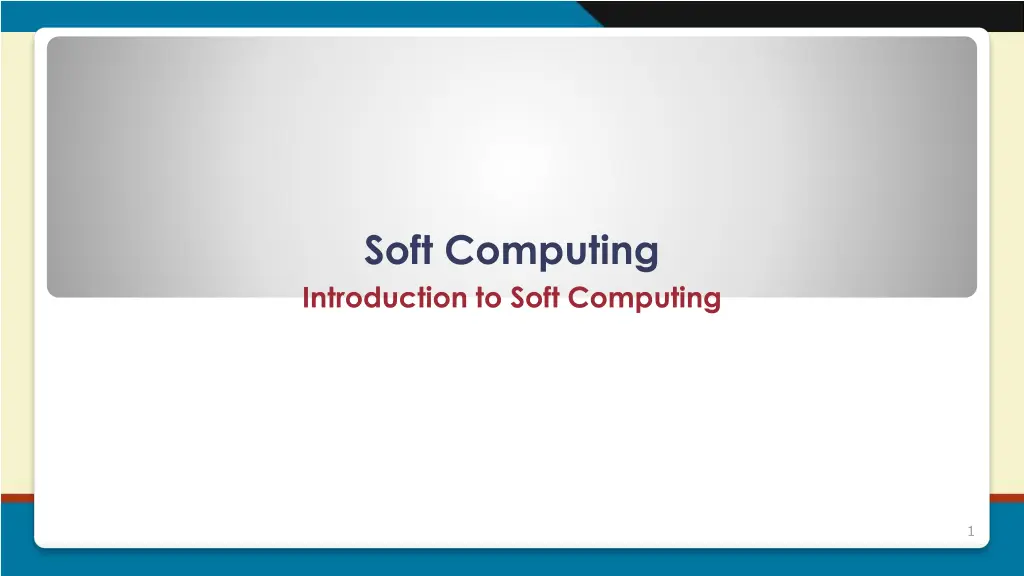
Soft Computing: Introduction and Concepts for Efficient Problem Solving
Explore the world of soft computing through an introduction to the concept of computation, the differences between hard and soft computing, and the essential characteristics of computing methods. Learn about precise solutions, unambiguous control actions, and the adaptability of algorithms in soft computing. Delve into examples of hard computing and the innovative approaches of soft computing inspired by human and biological systems.
Download Presentation

Please find below an Image/Link to download the presentation.
The content on the website is provided AS IS for your information and personal use only. It may not be sold, licensed, or shared on other websites without obtaining consent from the author. If you encounter any issues during the download, it is possible that the publisher has removed the file from their server.
You are allowed to download the files provided on this website for personal or commercial use, subject to the condition that they are used lawfully. All files are the property of their respective owners.
The content on the website is provided AS IS for your information and personal use only. It may not be sold, licensed, or shared on other websites without obtaining consent from the author.
E N D
Presentation Transcript
Soft Computing Introduction to Soft Computing 1
INTRODUCTION TO SOFT COMPUTING Concept of computation Hard computing Soft computing How soft computing? Hard computing vs. Soft computing Hybrid computing 2
CONCEPT OF COMPUTATION Computi ng ? = ?(?) Antecede nt Conseque nt Control Action Figure: Basic of computing ? = ? ? ,? is a mapping function. ? is also called a formal method or an algorithm to solve a problem. 3
Important characteristics of computing Should provide precise solution. Control action should ne unambiguous and accurate. Suitable for problem, which is easy to model mathematically. 4
Hard computing In 1996, L. A. Zade (LAZ) introduced the term hard computing. According to LAZ: We term a computing as Hard computing, if Precise result is guaranteed. Control action is unambiguous. Control action is formally defined (i.e., with mathematical model or algorithm). 5
Examples of hard computing Solving polynomials, integration, etc.). numerical problems (e.g., roots of Searching and sorting techniques. Solving computational geometry problems (e.g., shortest tour in a graph, finding closet pair of points given a set of points, etc.). many more 6
Soft computing The term soft computing was proposed by the inventor of fuzzy logic, Lotfi A. Zadeh. He describes it as follows. Definition 1: Soft computing Soft computing is a collection of methodologies that aim to exploit the tolerance for imprecision and uncertainty to achieve tractability, robustness, and low solution cost. Its principal constituents are fuzzy logic, neuro-computing, and probabilistic reasoning. The role model for soft computing is the human mind. 7
Characteristics of soft computing It does not require any mathematical modeling of problem solving. It may not yield the precise solution. Algorithms are adaptive (i.e., it can adjust to the change of dynamic environment). Use some biological inspired methodologies such as genetics, evolution, Ant s swarming, human nervous system, etc.). behaviors, particles 8
Examples of soft computing Soft computin g Example: Hand written character recognition (Artificial Neural Networks) 9
Examples of soft computing Soft Bank with maximum return computin g Example: Money allocation problem (Evolutionary Computing) 10
Examples of soft computing- Example: Robot movement (Fuzzy Logic) 11
How soft computing? How a student learns from his teacher? Teacher asks questions and tell the answers then. Teacher puts questions and hints answers and asks whether the answers are correct or not. Student thus learn a topic and store in his memory. Based on the knowledge he solves new problems. This is the way how human brain works. Based on this concept Artificial Neural Network is used to solve problems. 12
How soft computing? How world selects the best? It starts with a population (random). Reproduces another population (next generation). Rank the population and selects the superior individuals. Genetic algorithm is based on this natural phenomena. Population is synonymous to solutions. Selection of superior solution is synonymous to exploring the optimal solution. 13
How soft computing? How a doctor treats his patient? Doctor asks the patient about suffering. Doctor find the symptoms of diseases. Doctor prescribed tests and medicines. This is exactly the way Fuzzy Logic works. Symptoms are correlated with diseases with uncertainty . Doctor prescribes tests/medicines fuzzily. 14
Hard computing vs. Soft computing Hard computing It requires a precisely stated analytical model and often a lot of computation time. It is based on binary logic, crisp systems, analysis and crisp software. Soft computing It is tolerant of imprecision, uncertainty, partial truth, and approximation. It is based on fuzzy logic, neural nets and probabilistic reasoning. It has the characteristics of approximation dispositionality. numerical It has the characteristics of precision and categoricity. and 15
Hard computing vs. Soft computing Hard computing It is deterministic. It requires exact input data. Soft computing It incorporates stochasticity. It can deal with ambiguous and noisy data. It allows computations. It can yield approximate answers parallel It is strictly sequential. It produces precise answers. 16
Hybrid computing It is a combination of the conventional hard computing and emerging soft computing. S C H C Hybrid computing Figure: Concept of Hybrid Computing 17
In this course You will be able to learn Basic concepts of Fuzzy algebra and then how to solve problems using Fuzzy logic. The framework of Genetic algorithm and solving varieties of optimization problems. How to build an artificial neural network and train it with input data to solve a number of problems, which are not possible to solve with hard computing. 18
